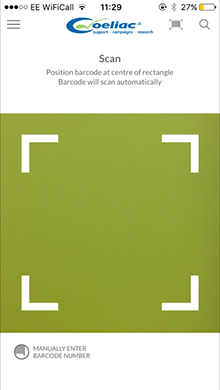Frequently Asked Questions Find everything you need to know about coeliac disease, the gluten free diet and the work we do.
Found 9
What products can't display the Crossed Grain symbol?
The Crossed Grain symbol can be licensed only for multiple ingredient and/or processed products. Products cannot be licensed if they are composed of a single ingredient or are unprocessed in nature. For example, fresh fruit and vegetables cannot be licensed as they are naturally gluten free; but fruit bars can be licensed as they have undergone a process which may hold a risk for gluten contamination.
For a full list of products that cannot be licensed see Appendix One ‘List of food products which are not permitted to bear the Crossed Grain Trademark’ in the certification pack.
How can I find a distributor for my gluten free products?
There are numerous information sources which you can access for further information about potential distribution channels, both online and in print, for example The Grocer or CheckoutMagazine.
Some of the major trade shows in the UK can also be a useful source of information and contacts.
Can I eat yeast?
Fresh yeast is naturally gluten free. We are now aware of some brands of dried yeasts that now contain wheat starch in the ingredients so they are not gluten free. We therefore now list dried yeasts on our Food and Drink Information Service that do not contain gluten.
How do I use the barcode scanner?
Select the barcode scanner icon and position the barcode in the centre of the screen. The barcode will scan automatically. If the barcode will not scan you can manually enter the barcode number by selecting this icon:

For some Android mobile devices the scanner will only work if the device is held in a portrait position and the barcode in a landscape position.
I'm thinking of setting up a business making gluten free products, how can you help?
Coeliac UK can help by providing you with the latest information on the gluten free market, legislation, labelling, quality control and gluten testing.
We produce a range of resources for people on a gluten free diet which have a wide variety of opportunities for promoting your business to your target market.
You can find out more about how Coeliac UK can help make your gluten free business a success here.
What does 'gluten free' really mean?
The term 'gluten free' implies no gluten, but in practice it is not possible to test for a zero level of gluten.
Research has shown that people with coeliac disease are able to safely tolerate a very small amount of gluten. As a result low levels of gluten (below 20 parts per million) are allowed in products that are labelled gluten free.
For more information visit our gluten free and the law page.
How do I get my products into the Food and Drink Guide?
If your products meet our criteria they could either be listed in our Food and Drink Guide which holds around 12,000 products or within our online Food and Drink Directory.
The Guide is printed annually with updates on a monthly basis including new and de-listed products and the Directory is updated on a daily basis. Inclusion is free of charge.
Please contact fdd@coeliac.org.uk for more information on how to submit your products.
What should I do if I have any other questions about the Challenge?
If you have any questions, please do not hesitate to contact the Coeliac UK Fundraising team on this email fundraising@coeliac.org.uk or call our dedicated Helpline on 0333 332 2033 between 10am and 4pm Monday to Friday.
Remember we are here to help and to guide you through your challenge or event.
Are there any incentives for pharmacists taking part in the Community pharmacy supply of gluten-free foods scheme?
Introducing a pharmacy led supply scheme allows better stock control of gluten-free foods for pharmacists as well as providing a more flexible service to improve the patient experience.
Pharmacists and GP dispensaries are paid a service charge at six monthly intervals for each patient who accesses the service. When the scheme in Northamptonshire was introduced it was run as an Enhanced Service with funding for this element of the contract coming from Primary Care Contracting budgets.